A Bulgarian by descent, Bistra Johnson is based in Paris and has given much time to her writing career. She recently released an English-language book The City That Does Not Age: The History of Sofia. It offers readers a journey into the turbulent history of the ancient city which has been part of three empires. We talked with Bistra Johnson about her roots in Bulgaria and her quests in writing.
And here is an excerpt from the book The City That Does Not Age: The History of Sofia:
THE CITY THAT DOES NOT AGE
Bistra Johnson
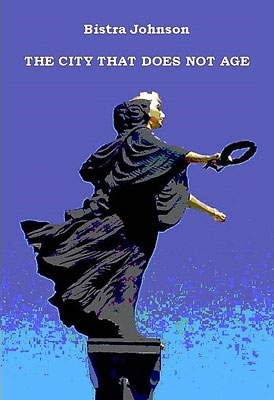 The bronze statue of St. Sofia on her high pedestal at the central square Nezavisimost is striking. She wears a long, very revealing black dress and sports a golden crown; a laurel wreath in her right hand, an owl perched on her left arm, this Nike and Athens rolled into one with a golden face, looks ahead into the future. Below her, the past is embodied by a tiny church, St. Petka, huddled half buried on a small mound amidst archaeological digs from the Roman era. On its facade -
The bronze statue of St. Sofia on her high pedestal at the central square Nezavisimost is striking. She wears a long, very revealing black dress and sports a golden crown; a laurel wreath in her right hand, an owl perched on her left arm, this Nike and Athens rolled into one with a golden face, looks ahead into the future. Below her, the past is embodied by a tiny church, St. Petka, huddled half buried on a small mound amidst archaeological digs from the Roman era. On its facade - 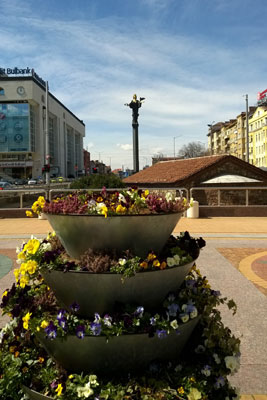 the stylized image of the saint, a pious looking woman, is glancing somewhat sideways at the glamorous newcomer, the statue of St. Sofia. Meant as a New Age symbol of the city that “grows but does not age”, the statue of St. Sofia was erected there at the dawn of the new Millennium to replace the marble statue of Lenin. But who is she exactly? The city's patron, the goddess of wisdom? Surely the goddess of wisdom, according to the Greek mythology, is Athens and she's given her name to the Greek capital. Where does Sofia come into this equation? And if a saint - where is the halo, if she wasn't a queen, why does she have a crown? Let's go back in time, to the pre-Christian period of pagan religions. Patron saint is the Christian substitute for a tutelary deity - a protector, as Pallas Athena is the patron goddess of Athens. But lots of cities in antiquity opted for the goddess Tyche (“luck” in Greek), who determines the fate and prosperity of the city. Each would come up with their own Tyche, identifiable by her so called “mural crown”, which represents the city walls.
the stylized image of the saint, a pious looking woman, is glancing somewhat sideways at the glamorous newcomer, the statue of St. Sofia. Meant as a New Age symbol of the city that “grows but does not age”, the statue of St. Sofia was erected there at the dawn of the new Millennium to replace the marble statue of Lenin. But who is she exactly? The city's patron, the goddess of wisdom? Surely the goddess of wisdom, according to the Greek mythology, is Athens and she's given her name to the Greek capital. Where does Sofia come into this equation? And if a saint - where is the halo, if she wasn't a queen, why does she have a crown? Let's go back in time, to the pre-Christian period of pagan religions. Patron saint is the Christian substitute for a tutelary deity - a protector, as Pallas Athena is the patron goddess of Athens. But lots of cities in antiquity opted for the goddess Tyche (“luck” in Greek), who determines the fate and prosperity of the city. Each would come up with their own Tyche, identifiable by her so called “mural crown”, which represents the city walls. 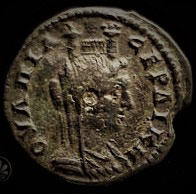 Julia Domna, the wife of the Roman Emperor Septimius Severus was depicted on a coin from Roman Serdica (Sofia), precisely as Tyche with a mural crown. The name Sofia itself comes from the name of the oldest Christian basilica. There was a Christian martyr St. Sofia, whose day, September 17th , became the day of the city. But in fact the church is named Hagia Sophia, which means Holy Wisdom in Greek.
Julia Domna, the wife of the Roman Emperor Septimius Severus was depicted on a coin from Roman Serdica (Sofia), precisely as Tyche with a mural crown. The name Sofia itself comes from the name of the oldest Christian basilica. There was a Christian martyr St. Sofia, whose day, September 17th , became the day of the city. But in fact the church is named Hagia Sophia, which means Holy Wisdom in Greek. 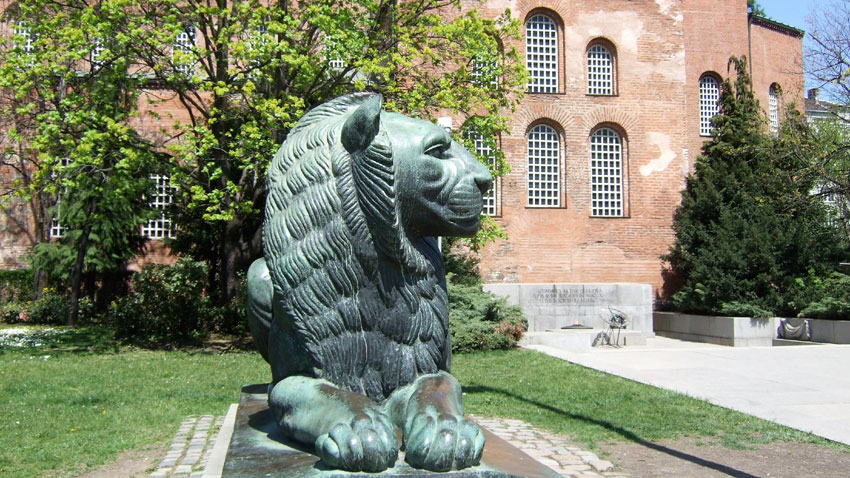 Remarkable church, Hagia Sophia, it is very different from her glamorous and world renowned counterpart in Constantinople/Istanbul, Turkey. Yet they date from about the same time (6th century AD). Byzantine Emperor Justinian the Great who had rebuilt the Hagia Sofia church in Constantinople also rebuilt its namesake in Serdica, but in a very different style; an imposing, yet simple, red brick basilica of eternal beauty that the vagaries of time have spared to this day. The story of the sickly daughter of Justinian, who miraculously recovered after taking the waters, is a legend, but the hot mineral springs and their healing properties had been renowned since Antiquity. The oldest settlements discovered on the territory of Sofia date from the Neolithic.
Remarkable church, Hagia Sophia, it is very different from her glamorous and world renowned counterpart in Constantinople/Istanbul, Turkey. Yet they date from about the same time (6th century AD). Byzantine Emperor Justinian the Great who had rebuilt the Hagia Sofia church in Constantinople also rebuilt its namesake in Serdica, but in a very different style; an imposing, yet simple, red brick basilica of eternal beauty that the vagaries of time have spared to this day. The story of the sickly daughter of Justinian, who miraculously recovered after taking the waters, is a legend, but the hot mineral springs and their healing properties had been renowned since Antiquity. The oldest settlements discovered on the territory of Sofia date from the Neolithic. 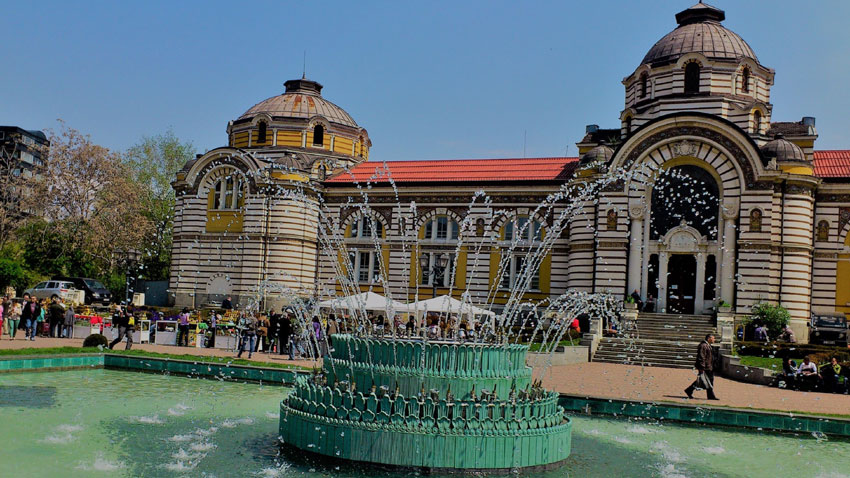 Balneotherapy must have come into fashion about then. And yet, there are no more mineral baths in the city today; just water fountains where people come to fill their bottles! The splendid building that used to house the Central Mineral Baths, now restored, is turned into a museum of Sofia! Sofia of today is well and truly a 21st century city. But should you care to look past the modern facades, you'll still find the remains of the ancient metropolis. The area around St. Petka's church, once again exposed to the elements, is really the open heart of Roman Serdica. So we can literally walk in the footsteps of Constantine the Great, who called it “my Rome”! The gods of the underworld have let us recuperate what was once ours. In one other respect they have been generous: the thermal mineral water still flows as freely as it ever did. Come, cup your hands underneath and drink as much as you like - it is delicious!
Balneotherapy must have come into fashion about then. And yet, there are no more mineral baths in the city today; just water fountains where people come to fill their bottles! The splendid building that used to house the Central Mineral Baths, now restored, is turned into a museum of Sofia! Sofia of today is well and truly a 21st century city. But should you care to look past the modern facades, you'll still find the remains of the ancient metropolis. The area around St. Petka's church, once again exposed to the elements, is really the open heart of Roman Serdica. So we can literally walk in the footsteps of Constantine the Great, who called it “my Rome”! The gods of the underworld have let us recuperate what was once ours. In one other respect they have been generous: the thermal mineral water still flows as freely as it ever did. Come, cup your hands underneath and drink as much as you like - it is delicious!
Photos courtesy of Bistra Johnson
The exhibition "The Transylvanian Medieval Fortress" by the Romanian artist Ovidiu Carpusor will be presented from November 9 to 23 in the "Quiet Nest" gallery of the Palace Architectural Park Complex in the town of Balchik , on Bulgaria's Northern Black..
The national painting triennial with the theme "Bridges" will bring together 84 contemporary artists who will show 106 works in the Hristo Tsokev Art Gallery in Gabrovo. This year's theme of the exhibition - "Bridges" - includes two aspects,..
The OKO International Ethnographic Film Festival will be held in Sofia in the period November 8 to November 15th. The forum is realized with the support of the National Film Center, Sofia Municipality, the Embassy of Ukraine and the..
“A story that is worthy of a movie” is what we often say when we hear about some incredible event or an interesting story. It is cinema..
The fourth national Biennial of Illustrations opens today in the triangular tower of Serdica, part of the Regional Museum of History in Sofia. As..

+359 2 9336 661
